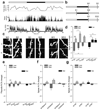Sleep and waking modulate spine turnover in the adolescent mouse cortex
- PMID: 21983682
- PMCID: PMC3203346
- DOI: 10.1038/nn.2934
Sleep and waking modulate spine turnover in the adolescent mouse cortex
Abstract
Cortical development involves synaptic formation and elimination. Although synaptogenesis predominates in the early stages and pruning in the later stages, the two processes are thought to happen concurrently. In adults, synaptic strength is modulated by behavioral state, and we asked whether synaptic remodeling may be affected by sleep and waking states. Using two-photon microscopy in adolescent mice, we found that waking results in a net increase in cortical spines, whereas sleep is associated with net spine loss.
Figures

References
Publication types
MeSH terms
Substances
Grants and funding
LinkOut - more resources
Full Text Sources

